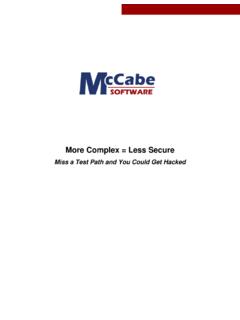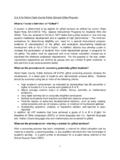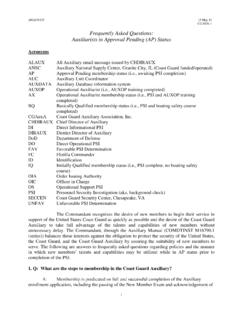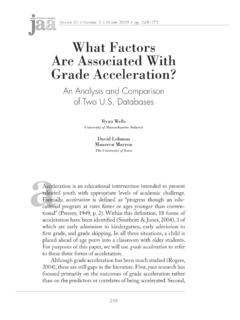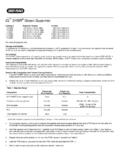Transcription of Software Security Analysis: Control Flow Security Analysis ...
1 Software Security Analysis : Control Flow Security Analysis with McCabe IQ Applying a Path-based Method to Vulnerability Assessment of the Microsoft SDL Banned Function Calls Control Flow Security Analysis with McCabe IQ McCabe Software , Inc. (800) 638-6316 URL- 41 Sharpe Drive Cranston, RI 02920 2 Introduction When considering Software Security Analysis , the primary concern is to ensure that the system is resistant to malicious misuse. However, Security vulnerabilities are also closely related to structural quality and implementation flaws. As Software becomes more complex, Security flaws are more easily introduced and more difficult to eliminate. Comprehensive Security Analysis requires insight into the structure of the Software code, to manage complexity and track possible execution flows , ensuring that all paths of execution are valid and secure.
2 Therefore, in addition to identifying potentially vulnerable areas, Security Analysis tools must also be cognizant of related Control flow paths surrounding them. McCabe IQ is a source code Analysis tool with a strong focus on function call relationships and Control flow paths. While many tools commonly detect potentially insecure code patterns, function calls, or expressions, discovery of the surrounding context is often left for the analyst to manually infer. McCabe IQ mitigates this arduous task, taking into account the complexity and connectedness of components when analyzing vulnerability. One of the industry leading processes for secure Software engineering is the Security Development Lifecycle (SDL) developed by Microsoft. The SDL defines a workflow that incorporates Security -related activities throughout Software development.
3 McCabe IQ s capabilities are best suited to the activities defined in the design, implementation, and verification phases of the SDL. Some of these activities include attack surface Analysis , static source code Analysis , and testing. McCabe IQ is designed to facilitate these efforts. This application note discusses the example of performing vulnerability assessment in relation to the use of certain exploitable functions in the C standard library. As part of the recommendations for the implementation phase, the Microsoft SDL identifies a set of functions that, from real-world experience, have been linked to many Security bugs because of buffer overruns and invalid pointer access. SDL practices suggest banning the use of these functions in favor of newer implementations that incorporate better bounds checking and are easier to secure.
4 Searching source code for banned function calls will readily identify the vulnerable points, but the exploitability of a given vulnerability is determined by whether it is reachable along an execution path from parts of the system accessible to an attacker. Exploitable vulnerabilities call for special attention to design remediation and adequate testing. The following sections describe activities that apply such practices using McCabe IQ. Analyzing Use of Banned Functions with Attack Maps Attack maps are Control flow diagrams that identify a set of interconnected routines in a system, that potentially participate in a malicious attack. An attack map is intended to show how call relationships and a flow of execution can connect externally triggered attacks to critical areas of the system.
5 The main window of the McCabe IQ application consists of a structure chart called the battlemap. This chart shows functions as boxes connected by lines indicating function call relationships. Attack maps allow you to filter the battlemap chart in a way that focuses attention on routines that lie along attackable execution flows . This section covers the following topics: Definitions Mapping the Banned Functions with McCabe IQ Further Analysis Activities Applying Code Coverage to Attackable Space Control Flow Security Analysis with McCabe IQ McCabe Software , Inc. (800) 638-6316 URL- 41 Sharpe Drive Cranston, RI 02920 3 Definitions An attack map connects two significant areas of interest: Attack Surface and Attack Target. The attack surface is generally known as the subset of input space with which a malicious user can exploit the system by giving it malformed data to trigger deviant behavior.
6 One of the heuristics of securing Software is reducing the attack surface. That is, minimize the number of external interfaces that influence system behavior. In a general sense, an attack surface encompasses code, interfaces, services, and protocols. However, within the scope of source code Analysis , the relevant attack surface consists of the areas of code where the system obtains external input. For example, the analyst might focus on input routines that accept data or read configuration files, environment variables, or registry entries that affect application behavior. It is important to identify these entry points and review them to assess their correctness and robustness. It is from this space where a malicious attack will originate. The other area of equal interest is called the attack target, which is defined as the areas of the system that can cause adverse critical impact if exploited.
7 The banned functions fit this category. Misuse of these APIs can cause significant consequences ranging from wasting system resources to program crashes and Security breaches. Given the attack surface and attack target, McCabe IQ can analyze function call relationships and direct attention to the routines that connect these two areas of concern. Mapping the Banned Functions with McCabe IQ Two McCabe IQ features are integral to mapping the banned functions. They are as follows: Using the Class Editor to Identify Attack Surface and Attack Target Using the Exclude Feature to Narrow the Scope of Analysis Using the Class Editor to Identify Attack Surface and Attack Target To create an attack map with McCabe IQ, the user must first identify functions in the attack surface and attack target groups.
8 This is done by using the McCabe IQ Class Editor, available from the View menu of the main application window. For purposes of attack maps, classes are simply used as a way of grouping functions together. Analyzing calls to banned functions in the standard C library is particularly easy because the list of these functions is readily available, and is easily preconfigured in the McCabe IQ Class Editor. To identify functions in the attack surface, create a class called AttackSurface, and add to its contents the routines from the input space that you wish to trace (see the screenshot below). For example, in a network application, the recv() function, which receives data from a socket, may be of interest. With the AttackSurface class highlighted from the class list, you can manually type in MODULE modulename in the User Class File Contents box, or simply clicking a module box in the battlemap will add it to the current class.
9 You can add as many functions as you wish to the AttackSurface class, although the more functions you add, the more inclusive (larger) the map will be. You can also use the NESTED classname specification to add a group of functions as part of the AttackSurface class. The AttackTarget class in the following paragraph of this example uses this technique. Control Flow Security Analysis with McCabe IQ McCabe Software , Inc. (800) 638-6316 URL- 41 Sharpe Drive Cranston, RI 02920 4 To configure a set of banned functions as the attack target, create a class called AttackTarget and add to its contents the subset of banned functions you are interested in tracing (see the screenshot following). In this example, the AttackTarget is configured to consist of the banned variants of strcpy().
10 Notice that the syntax in the User Class File Contents box says NESTED MicrosoftSDL_BannedStrCpy. This is because the prepopulated class list includes a class named MicrosoftSDL_BannedStrCpy, whose contents consist of the banned strcpy() function names. As with the attack surface, you can also specify individual functions using the MODULE modulename specification. Again, you can add as many target functions as you wish to the AttackTarget class. The screenshot below illustrates how you can specify NESTED classname to nest group definitions and create aggregate hierarchies according to your needs. This allows flexibility for easily configuring the function calls you wish to trace. Finally, you must define a class called AttackMap that nests the AttackSurface and AttackTarget classes (see the following screenshot).
